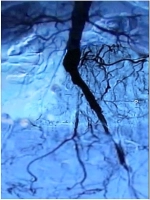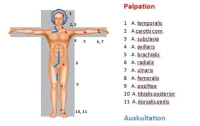Depending on the length of the local occlusion/stenosis, the TASC III criteria suggest the treatment options to be used. The length of the stenosis and the region where it is located determine the general type of management: Endovascular or open vascular surgery.
TASC II classification in aortoiliac occlusion
| Lesion type | Morphology | Recommended treatment |
A | Short (<3 cm) unilateral or bilateral stenosis of the CIA or EIA | Endovascular |
B | Single or multiple stenosis totaling 3–10 cm involving the EIA, not extending into the CFA; and/or unilateral CIA occlusion | Endovascular |
C | Bilateral CIA occlusion;[MM3] bilateral EIA stenoses 3–10 cm long not extending into the CFA; unilateral complete EIA occlusion | Open reconstruction |
D | Diffuse disease involving the aorta and both iliac arteries requiring treatment; unilateral occlusions of both CIA and EIA; bilateral occlusions of EIA | Open reconstruction |
Video example
Clinically the patient is classified as Fontaine PAOD IIb–III and the preoperative angiogram demonstrates: Occlusion of the right CIA and EIA, subtotal stenosis of the left EIA and bilateral stenosis of the femoral bifurcation
-> TASC D, , thus recommendation for open revascularization
PAOD classification according to Fontaine and Rutherford
Fontaine stage | Clinical symptoms | Rutherford | Grade | Clinical symptoms |
I | Asymptomatic | 0 | 0 | Asymptomatic |
IIa | Distance > 200 m | 1 | I | Mild claudication |
IIb | Distance< 200 m | 2 | I | Moderate claudication |
| 3 | I | Severe claudication | |
III | Ischemic rest pain | 4 | II | Ischemic rest pain |
IV | Ulcers or gangrene | 5 | III | Ischemic ulceration not exceeding ulcer of the digits of the foot |
6 | III | Severe ischemic ulcers or frank gangrene |




